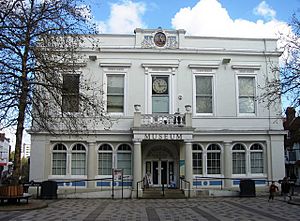Willis Museum facts for kids
Quick facts for kids Willis Museum |
|
|---|---|

The old Town Hall, now the Willis Museum
|
|
| Location | Market Place, Basingstoke |
| Built | 1835 |
| Architect | Lewis Wyatt |
| Architectural style(s) | Neoclassical style |
|
Listed Building – Grade II
|
|
| Official name: Town hall with attached drinking fountain | |
| Designated | 6 November 1984 |
| Reference no. | 1230876 |
| Lua error in Module:Location_map at line 420: attempt to index field 'wikibase' (a nil value). | |
The Willis Museum is a cool local history museum in Basingstoke, England. It's located in the Market Place in Hampshire. The building itself is very old and special. It used to be called Basingstoke Town Hall. Today, it's a Grade II listed building, which means it's protected because of its history.
Contents
History of the Willis Museum
The Museum Building
For a very long time, since the 1300s, there was a meeting hall in Market Place. The building you see today was finished in 1835. It was designed by an architect named Lewis Wyatt. He used a style called neoclassical. This style often looks like ancient Greek or Roman buildings.
The building first had a small clock tower. In 1887, a much bigger clock tower was added. This was to celebrate Queen Victoria's Jubilee. Sadly, this big tower was taken down in 1961 because it was old. But the clock inside was saved! This clock was made in 1760 for the old meeting hall. It was used again in the new town hall in 1832. Then, it was used a third time in the 1887 tower.
At first, the ground floor of the building was open. It was used as a market for corn and other goods. Later, a new corn market was built nearby. So, the open area was closed off. It became office space instead. The rest of the building was used as the town hall. It also had a court where judges worked. Sometimes, fun dances were held upstairs too!
In 1922, the town council bought a new office building. But they still met in the old town hall. This continued until 1974. After that, the town hall was no longer needed for council meetings.
How the Museum Started
The museum didn't always start in this building. It first opened in 1931 in a different place. A local clockmaker named George W. Willis started it. It was first called the Basingstoke Museum. In 1956, it was renamed the Willis Museum. This was to honor its founder.
The museum grew to show the history of Basingstoke. It covers everything from ancient times to the 1960s and 1970s. In 1984, the museum moved into the old Town Hall building. The museum gets money from visitors. It also gets grants from the Basingstoke and Deane Borough Council.
What You Can See at the Museum
The museum has many interesting things on display. You can learn about local history. There are even remains of an ancient human. This person is known as "Basingstoke Man." The museum also has what people say is the world’s oldest wedding cake!
The museum has a special area called the Sainsbury Gallery. This gallery hosts different temporary exhibitions. It was added to the museum in 2008. The Linbury Trust helped fund it. This trust was started by Lord Sainsbury.
Some past exhibitions in the Sainsbury Gallery have included:
- May The Toys Be With You
- Turner and the Sun
- Alice in Wonderland
Jane Austen Statue
Outside the museum, there is a statue of Jane Austen. She was a famous writer. The statue is made of bronze and is life-sized. A sculptor named Adam Roud created it. It was made to celebrate 200 years since Jane Austen passed away. This statue is thought to be the first one of Austen in the world!
The spot for the statue was chosen carefully. It's believed to be the same area Jane Austen would have visited. She might have gone shopping there. Or she might have danced at the assembly rooms nearby. The statue was shown to the public at a special event. Many people came, including fans of Jane Austen. Some even dressed in old-fashioned clothes!
Jane Austen lived the first 25 years of her life nearby. Her father was a vicar in Steventon. The sculptor, Adam Roud, said the statue shows Austen as a "daughter and a sister." It shows her walking through the town.

